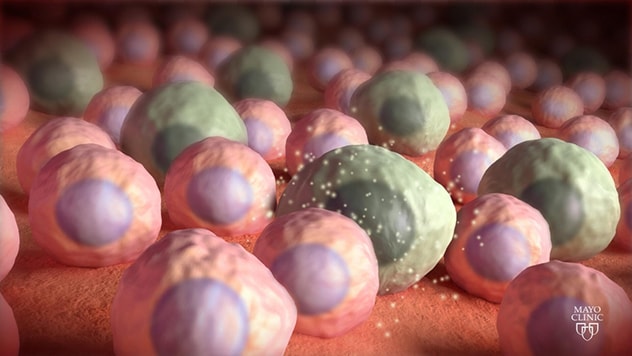Feb. 06, 2025
 Senescent cells
Senescent cells
With age, cells can experience senescence, a state where they stop growing but continue releasing inflammatory and tissue-degrading molecules.
Cellular senescence is a cell state that occurs in response to diverse forms of stress and a hallmark of aging. As individuals age, senescent cells accumulate in many tissues and mediate inflammation, deterioration and cellular remodeling. Senescent cells also reduce regenerative capacity, both locally and systemically.
Efforts to identify both behavioral and pharmacological interventions to modify senescent cell burden are underway. Nathan K. LeBrasseur, Ph.D., M.S., and colleagues at Mayo Clinic have spent the last 15 years studying cellular senescence and other biological processes that drive aging. One of their goals is to develop novel interventions that delay or prevent age-related conditions. Dr. LeBrasseur is the Noaber Foundation Professor in Aging Research and the director of the Robert and Arlene Kogod Center on Aging at Mayo Clinic.
In studies published in Diabetes in 2016, and in Exercise and Sport Sciences Reviews in 2022, Dr. LeBrasseur and colleagues showed that endurance exercise training can reduce the senescent cell burden in mice. And they provided the scientific rationale for why exercise is a promising means to both prevent and promote the clearance of senescent cells. In a study published in Aging Cell in 2021, Dr. LeBrasseur and colleagues demonstrated that a 12-week structured exercise program can lower the concentration of blood-based senescence biomarkers in healthy older adults.
Building on this body of work, Dr. LeBrasseur and colleagues recently conducted a study to assess whether lifestyle interventions have the potential to mitigate cell senescence in older adults with clinical signs of advanced biological age, including functional limitations and multimorbidity. The results of this study were published in The Journals of Gerontology, Series A: Biological Sciences and Medical Sciences in 2024.
Study scope and methods
Dr. LeBrasseur and colleagues analyzed longitudinal data and blood samples obtained from participants in the Lifestyle Interventions in Elders (LIFE) Study. The LIFE Study was a large, single-blind, multicenter clinical trial comparing data obtained from older men and women who were randomized to either a two-year structured physical activity program (PA group) or a healthy aging education-based program (HA group).
The Mayo Clinic researchers analyzed data and blood samples from 1,377 of the 1,635 participants in the LIFE Study to test a two-part hypothesis:
- That baseline plasma biomarkers of cellular senescence can predict functional decline, defined by incidence of major mobility disability (the inability to walk 400 m or to walk 400 m in 15 min or less) and reductions in performance on the short physical performance battery (SPPB), a combined measure of gait speed, repeated chair rise time and standing balance. These measures were assessed at six, 12 and/or 24 months.
- That participants randomized to the PA group would demonstrate lower senescence biomarker levels at the 12- and 24-month time points than those randomized to the HA group.
Key findings
Overall, the researchers observed significant associations between several senescence biomarkers and the onset of major mobility disability, including vascular endothelial growth factor A (VEGFA), tumor necrosis factor receptor 1 (TNFR1) and matrix metallopeptidase 7 (MMP7).
- VEGFA, growth differentiation fac¬tor 15 (GDF15), osteopontin and other senescence biomarkers were associated with reductions in SPPB scores.
- When comparing participants in the PA and HA groups, changes in individual biomarker levels (from baseline to 12 months or from baseline to 24 months) did not differ significantly.
- In the whole cohort of participants, higher levels of PA were associated with significantly greater reductions in 10 senescence-related proteins at both 12 and 24 months.
- Overall, higher levels of PA significantly reduced the incidence of mobility disability when compared with HA.
"Our findings support the idea that cellular senescence contributes to age-associated functional decline and physical limitations, and that physical activity is an effective means to counter the biology of aging," explains Dr. LeBrasseur. A clinical trial testing the hypothesis that higher level physical activity interventions reduce senescent cell burden in tissue and circulating levels of senescence biomarkers is an appropriate next step."
For more information
Schafer MJ, et al. Exercise prevents diet-induced cellular senescence in adipose tissue. Diabetes. 2016;65:1606.
Zhang X, et al. Exercise counters the age-related accumulation of senescent cells. Exercise and Sport Sciences Reviews 2022;50:213.
Englund DA, et al. Exercise reduces circulating biomarkers of cellular senescence in humans. Aging Cell. 2021;20:e13415.
Fielding RA, et al. Biomarkers of cellular senescence predict the onset of mobility disability and are reduced by physical activity in older adults. The Journals of Gerontology, Series A: Biological Sciences and Medical Sciences. 2024;79:1.
Refer a patient to Mayo Clinic.